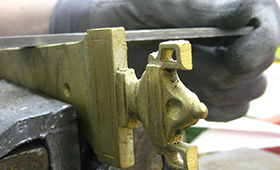Spinning, cutting and chasing – and other aspects of metal design
Modernisation of training in the occupation of decorative metal worker
29/2016 | Bonn, 20.06.2016

Very few people have much idea of what is involved in the shrinking, patinating, cutting and chasing of metals. These activities, however, all constitute training contents for decorative metal workers, a creative design occupation within the metal working sector. Acting on behalf of the Federal Government, the Federal Institute for Vocational Education and Training (BIBB) has joined forces with the social partners and with experts from the field of company practice to update the three-year course of VET in this area. The modernised training regulations that have resulted offer specialisms in crafting small metal items, metal spinning and metal chasing.
Most of us will be more familiar with the items which decorative metal workers produce than with the terms for the various manufacturing techniques. Products include banister rails, light fittings, candlesticks, door and furniture fittings, trophies and sacral objects. Trainees learn everything connected with the design of work pieces. Their training covers the preparation of technical drawings and samples and extends to encompass the use of cutting, reforming and surface-altering procedures. The subsequent joining of work pieces, surface treatment, final quality control and hand-over to customers also all form component parts of the vocational education and training.
Trainees are also given the opportunity to pursue various specialisms. The specialism of “crafting small metal items” involves working with moulded, hollow and cast parts. Electrification of components for use in objects such as illuminated letter box and bell systems also plays a role here. The specialism of “metal spinning” involves the manufacture of symmetrically rotating hollow bodies in basic conical, spherical and cylindrical forms, whilst “metal chasing” is characterised by the design manufacture of single and multiple casts for purposes such as making sculptures. The production of respective specialist tools is common to all three of these areas.
The modernised training regulations and the coordinated skeleton curriculum for the school-based part of the dual vocational education and training issued by the Conference of the Ministers of Education and Cultural Affairs in the Federal Republic of Germany (KMK) replace existing regulations which date back to 1998. The updated training regulations enter into force on 1 August 2016.
Depending on the specialism they have pursued, decorative metal workers are employed at companies which produce and design utilitarian and decorative metal objects. They also find work at metal spinning shops, at craft trade companies producing artistic goods or at foundries concentrating on the skilled production of decorative articles. Upon completing their training, skilled workers may go on to pursue a master craftsman qualification in one of the three specialisms. Continuing training leading to a qualification as metal engineering designer and occupationally specific courses of higher education study are also possible progression routes.
Further (German language) information on the new training regulations in the occupation of “decorative metal worker” is available at www.bibb.de/neue-berufe
Picture material may be accessed at www.bibb.de/pressefotos.
Contact partner at BIBB:
Markus Bretschneider; E-Mail: bretschneider@bibb.de
Reprint free of charge – voucher copy requested.